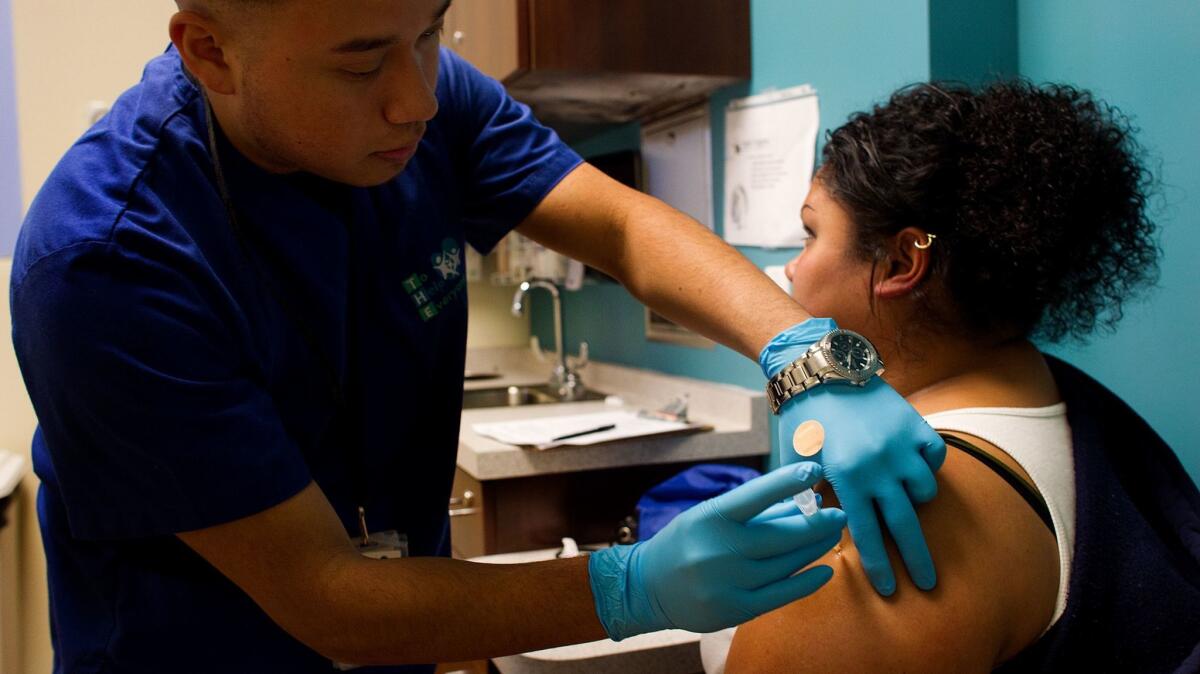America, it’s time to get ready for the flu

It’s the most wonderful time of the year — the time when the flu makes its presence known in the United States.
You may not have given influenza much thought, but that’s OK — health officials at the Centers for Disease Control and Prevention have been doing it for you. They say the virus had been lying low through October, but that’s changed since early November.
So far, the dominant strain of influenza here is of a sort that usually produces more misery. It’s also the type that’s less vulnerable to flu vaccines. Even so, health experts recommend that you get your annual flu shot, if you haven’t done so already.
“Peak influenza activity” usually occurs in the U.S. between December and February. In other words, the flu could strike at any time. It’s time to start paying attention.
Here’s a look at where things currently stand, courtesy of experts from the CDC’s National Center for Immunization and Respiratory Diseases. They published an update Thursday in the agency’s Morbidity and Mortality Weekly Report.
7,039
That’s the number of flu specimens that have been confirmed by laboratory tests between Oct. 1 and Nov. 25. It may sound like a lot, but it’s a small fraction of the nearly 144,000 samples that have been tested.
90%
That’s the percentage of influenza A virus samples that were subtyped and found to be of the H3N2 variety. The other 10% were H1N1 viruses, remnants of the 2009 “swine flu” outbreak.
H3N2 was the most common strain of flu in Australia during its 2017 flu season, which just ended. Preliminary estimates from health officials there suggest the flu vaccine did a poor job of protecting people, with an effectiveness of just 10%. Last week, Dr. Anthony Fauci of the National Institutes of Health warned that Americans could be in for a similar showing.
“In recent past seasons in which A(H3N2) viruses predominated, hospitalizations and deaths were more common, and the effectiveness of the vaccine was lower,” the CDC experts wrote in Thursday’s Morbidity and Mortality Weekly Report.
5
That’s the number of “novel” viruses that have been found in people for the first time. All five of these viruses are strains of influenza A, and all of them appear to be variants of flus that are known to circulate in pigs.
The people who were sickened with them were from Colorado, Iowa, Michigan, Nebraska and Ohio. Three of the five victims had recent, direct contact with pigs; the others were exposed to sick people, raising the possibility of limited human-to-human transmission. All five patients have fully recovered from the flu, though two required hospitalization.
3
The number of flu medications that are effective against the flu strains currently in circulation. They are: Tamiflu (oseltamivir), Relenza (zanamivir) and Rapivab (peramivir). The drugs stop new flu viruses from leaving their host cell and finding new cells to infect.
4
The number of states with “widespread” flu activity during the week ending Nov. 25. Three of them (Louisiana, Mississippi and South Carolina) had “high” numbers of patients with influenza-like illnesses, and one (Georgia) had “moderate” flu activity.
Flu and flu-like illnesses were judged to be “low” in 10 states (Alabama, Alaska, Arizona, Hawaii, Massachusetts, Nebraska, Oklahoma, South Dakota, Texas, and Virginia). The remaining 36 states had “minimal” flu activity.
The state of flu activity in Puerto Rico is unclear, the CDC monitors reported.
566
The number of patients hospitalized for a laboratory-confirmed case of the flu. That translates to an incidence of 2 patients per 100,000 Americans. About half of these patients were 65 years old or older.
5
The number of children who have died of the flu since Oct. 1. In past flu seasons, the total number of pediatric flu-related deaths has ranged from a low of 37 to a high of 171. During the swine flu pandemic, 358 children died of influenza between April 15, 2009, and Oct. 2, 2010.
Millions
The (rough) number of Americans who could be spared the flu by getting a flu shot, even if the vaccine’s effectiveness is somewhere between 30% and 60%. Vaccination would also prevent tens of thousands of flu-related hospitalizations.
38.6%
The percentage of Americans over the age of 6 months who had gotten a flu shot by early November. That’s slightly lower than it was at the same time last year, when 39.8% of Americans had been vaccinated.
Flu shot producers expect to make between 151 million and 166 million doses of vaccine this flu season. More than 148 million doses have been distributed already.
0
The number of “universal” flu vaccines approved for use. But scientists are working on them. They would train the immune system to recognize and attack parts of the flu virus that are common to all strains of influenza. That would eliminate the need for yearly flu shots.
Follow me on Twitter @LATkarenkaplan and "like" Los Angeles Times Science & Health on Facebook.
MORE IN SCIENCE
Found: The oldest known supermassive black hole in the universe
This weird, water-loving dinosaur has claws like a velociraptor and a neck like a goose
Widespread screening for breast cancer didn't do much to save women's lives, study finds




